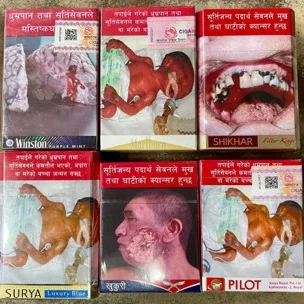- 14.05.2024
- Blog
Burning Issues: Nepal's Struggle Against Tobacco's Stranglehold on Health and Economy
The escalating impact of tobacco on the lives and health of the Nepalese is alarming. With a GDP loss of 1.04%, and 19.4% of deaths due to non-communicable diseases (NCDs), a large part of Nepalese mortality is attributable to the fact that 31.7% of the population use tobacco products.
from Anjana Lamichhane
Legal battles have been fought and 90% pictorial health warnings are now in place, but despite a commendable step in raising the excise tax in the last two years, taxation remains below recommended levels. Research that shows a negligible (0.33%) prevalence of illicit cigarettes challenges existing debates. The government's ongoing trust in the tobacco industry's claims of illicit trade, and concerns about the industry's economic impact hinders further tax increases. Evidence and measures presented by advocates are ignored. For a tobacco-free future, Nepal must prioritise evidence-based policies, increase taxation, monitor the industry more closely, and ensure effective implementation of adequate control policies.
The Widespread Impact of Tobacco
Tobacco use is having a significant and growing negative impact on the health and lives of the Nepalese people. It plays a major role in the proliferation of non-communicable diseases – the largest cause of death in Nepal, responsible for one out of every five deaths (19.4%). [1] Beyond health, its economic costs were 1.04% of GDP in 2020 (around USD 300 million). Following the ratification of the WHO Framework Convention on Tobacco Control on 7 November 2006, Nepal has implemented several measures to control tobacco use, including passing the Tobacco Products (Control and Regulatory) Act (2011), introducing requirements for cigarette packets to have health warnings covering over 75% of the package, and banning advertisements of tobacco products.[2]

Legal Milestones and Persistent Challenges
Im Jahr 2015 verabschiedete Nepal Vorschriften zur Ausweitung der bildlichen Warnhinweise auf 90 % der Oberfläche von Zigarettenpackungen – ein Meilenstein, der dem Land internationale Anerkennung und den renommierten Bloomberg Award einbrachte.[3] Die Tabakindustrie reichte jedoch beim Obersten Gerichtshof eine Petition gegen die Regierungsverordnung ein, was zu einer Gegenklage von Vertreterinnen und Vertretern der öffentlichen Gesundheit führte. Nach einem achtjährigen Rechtsstreit entschied der Oberste Gerichtshof Nepals am 28. August 2022 zugunsten des Schutzes der öffentlichen Gesundheit und verpflichtete die Industrie, auf 90 % der Tabakverpackungen bildliche Gesundheitswarnungen aufzudrucken (Abbildung 2).[4]

Continued High Prevalence of Tobacco Use
Despite determined efforts to reduce tobacco use in Nepal, the prevalence of tobacco use has remained consistently high over the last decade. According to the STEPS survey, the prevalence was 30.8% in 2012/13 and 28.9% in 2019. [5] [6] Most recently, NDRI’s survey in December 2019 found even higher prevalence rates, at 31.7%. [7]The consistently high smoking prevalence rates in Nepal suggest that tobacco will continue to be a major cause of ill health and premature death in the future unless there is decisive government action.
Importance of Taxation and Pricing
One of the most effective strategies to reduce tobacco consumption is through taxation. [8] However, tax rates on tobacco in Nepal remain substantially lower than regional and international recommendations. After years of advocacy, the Nepal government increased the excise tax by 25% (the highest in two decades) and implemented a 20% health hazard tax for the fiscal year 2021/22, along with a 20% excise increase for FY 2022/23, a commendable effort. Despite these increases, the tax as a percentage of the retail price in Nepal is only 41%, and considering inflation, it now stands at around 39%. [9] This has further contributed to the increased affordability of tobacco products in Nepal. An argument against further tax increases has been the fear of encouraging illicit trade. However, research conducted by NDRI in 2022 reveals that the prevalence of illicit cigarettes in Nepal is negligible – less than 1 percent (0.33%) of sampled packets – disproving the claim of the tobacco industry.[10] Despite this evidence, the government continues to believe in the tobacco industry’s assertions, hesitating to raise taxes due to concerns about illicit trade, industry impact, and substitution issues. The hesitation for taxation thus persists, even though evidence from tobacco advocates and researchers supports tax increases to reduce tobacco consumption.
Conclusion
While Nepal has commendable tobacco control policies on paper, they often remain limited in practice. Therefore, Nepal must prioritise evidence-based policies like higher tobacco taxation, confront industry influence, and ensure effective implementation to achieve a tobacco-free future and protect public health.
Ms. Anjana Lamichhane holds a master's degree in economics from Tribhuvan University in Nepal and currently serves as a Research Associate in the Economics and Health program at the Nepal Development Research Institute (NDRI). She is associated with the Cancer Research UK Fund's Tobacco Control Program, working towards the goal of advocating for evidence-based tobacco control policies in Nepal.
As a researcher/economic analyst, Anjana plays an essential role in researching the adverse effects of tobacco on both public health and the national economy, assessing the effectiveness of tobacco tax, and advocating government to implement effective tobacco control policies. Her commitment to this vital cause is evident in her contributions to the program, reflecting her passion for making a positive impact on society. Through her work, Anjana Lamichhane continues to make efforts to improve public health and promote a thriving economy in Nepal.
Organisation: Nepal Development Research Institute, Lalitpur, Nepal

[1] Institute for Health Metrics and Evaluation (IHME): 2019 (http://ghdx.healthdata.org/gbd-results-tool, zuletzt besucht am 31. Juli 2023.
[3] https://www.citizen-news.org/2015/03/wake-up-call-for-south-asian-nations.html
[4] https://theunion.org/news/public-health-win-supreme-court-of-nepal-dismisses-industry-challenge
[5] Non-communicable Disease Risk Factors: STEPS Survey Nepal 2013. URL: https://nhrc.gov.np/wp-content/uploads/2017/02/noncommunicable-disease-report_2012_2013.pdf
[6] Non-communicable Disease Risk Factors: STEPS Survey Nepal 2019. URL: https://www.who.int/docs/default-source/nepal-documents/ncds/ncd-steps-survey-2019-compressed.pdf
[9] https://ndri.org.np/publication/details/policy-paper-excise-tax-on-cigarettes-in-the-202324-budget
[10] Shakya S, Lamichhane A, Karki P, et al. Extent of illicit cigarette sales in Nepal: findings from a retail survey. Tobacco Control Published Online First: 6 April 2023. doi: 10.1136/tc-2022-057619 Published Online First: 6 April 2023. doi: 10.1136/tc-2022-057619